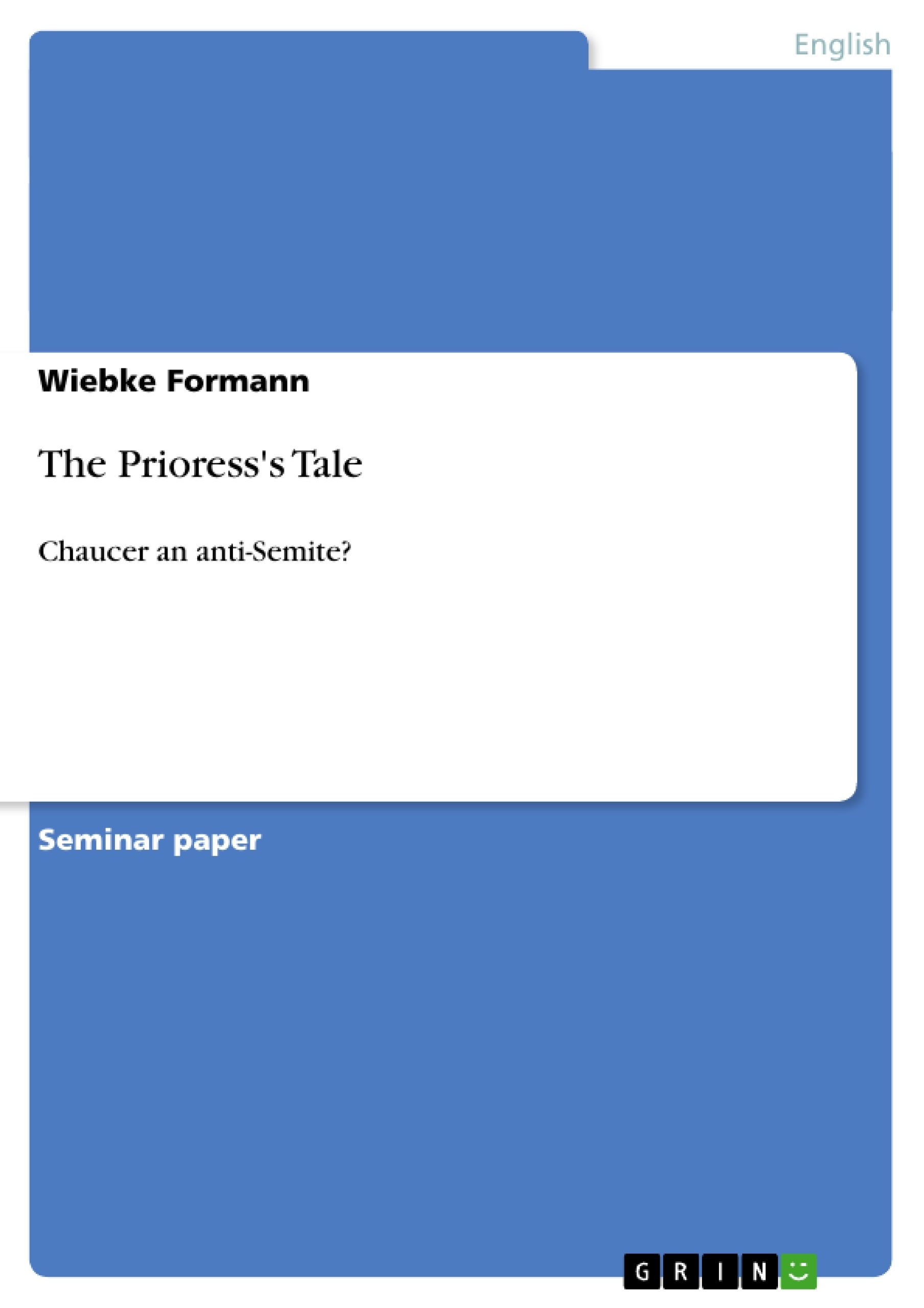An examination of a tale on anti-Semitism affords a clear definition of it. In addition one could argue if an examination of a medieval text on a matter - which has only been called by its name since 1880 - is appropriate. Anyway, in this comparatively short period of time many definitions of anti-Semitism have appeared surface, ranging from opposition to, hatred of, prejudice or discrimination against Jews and “one of the generally acknowledged intellectual heresies” to “taking a trait or an action that is widespread if not universal, and blaming only the Jews for it” . Taken literally, anti-Semitism does not only refer to the Jews, but to all ‘Semites’, which would also include the Arabs ; therefore anti-Judaism would be the more suitable term. Nevertheless I will make use of anti-Semitism in this paper because it is the well-established term and in contemporary application predominantly restricted to hostility towards the Jews.
In respect to the preceding definition, anti-Semitism is more than obvious in Chaucer’s Prioress’s Tale: The Jews murder - out of pure hatred - a little Christian boy who was just worshipping “His Lady” through his song and finally are tortured and killed. In the first chapter I will illustrate in detail to what extend the Prioress’s Tale is an anti-Semitic story.
As a matter of course the question raises, if Chaucer only illustrated the typical subjects of the time in the corresponding way or if he was well aware of the unfairness of the tale’s content. In other words: did he believe the Jews to be an evil people (as that was the common belief in medieval times) or did he present the Jews as wicked on purpose, and therefore on anti-Semitic grounds? I will deal with the implications of this question in chapters two and three respectively. In chapter two I will elaborate on the medieval image of the Jews on the basis of their depiction in contemporary literature and their political situation during the Middle Ages.
In order to convict Chaucer of being anti-Semitic or not, knowledge about the style of the tale and its intention is needed. In chapter three I will take into consideration Chaucer’s use of the Prioress as the narrator of the tale and describe Chaucer’s function as the author.
Finally I will evaluate the information gained from chapters one to three and present an answer to the crucial question: was Chaucer an anti-Semite?
Inhaltsverzeichnis (Table of Contents)
- INTRODUCTION
- 1. ANTI-SEMITISM IN THE PRIORESS'S TALE
- 2. THE MEDIEVAL IMAGE OF THE JEW
- 2.1. THE POLITICAL SITUATION OF THE JEWS IN BRITAIN DURING THE MIDDLE AGES
- 2.2. RITUAL MURDER ACCUSATIONS
- 2.3. THE JEWS IN MEDIEVAL LITERATURE
- 3. CHAUCER AND THE NARRATOR: THE PRIORESS
- 3.1. CHARACTERIZATION OF THE PRIORESS
- 3.2. THE ROLE OF THE PRIORESS
- 4. CONCLUSION
Zielsetzung und Themenschwerpunkte (Objectives and Key Themes)
This paper aims to examine the portrayal of anti-Semitism in Chaucer’s Prioress's Tale and investigate whether Chaucer himself can be considered anti-Semitic. The analysis will consider the historical context, the medieval perception of Jews, and the role of the Prioress as narrator.
- The presence of anti-Semitic themes in the Prioress's Tale
- The historical and literary context of anti-Semitism in medieval England
- The characterization of the Prioress and her role as narrator
- The question of Chaucer's own views on Jews and anti-Semitism
Zusammenfassung der Kapitel (Chapter Summaries)
- Chapter 1 focuses on identifying and analyzing the anti-Semitic elements within the Prioress's Tale. It examines specific passages that demonstrate the tale's portrayal of Jews as usurers, murderers, and followers of the devil.
- Chapter 2 delves into the medieval image of the Jews, exploring their political and social situation in Britain during the Middle Ages, the widespread accusations of ritual murder, and their representation in medieval literature.
- Chapter 3 investigates Chaucer's use of the Prioress as the narrator of the tale, analyzing her characterization and her role in shaping the story's perspective. This chapter also examines Chaucer's role as author and his potential influence on the tale's content.
Schlüsselwörter (Keywords)
The main keywords of this paper include: anti-Semitism, medieval literature, Chaucer, The Prioress's Tale, Jews, medieval image, usury, ritual murder, narrative perspective.
- Quote paper
- Wiebke Formann (Author), 2006, The Prioress's Tale, Munich, GRIN Verlag, https://www.grin.com/document/78337



